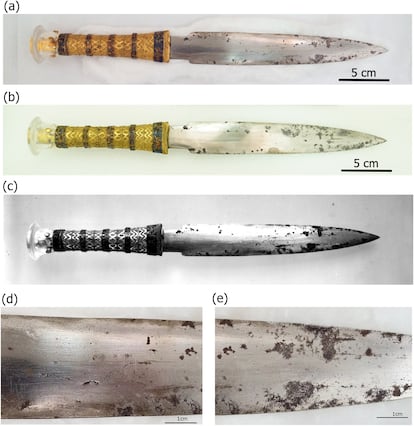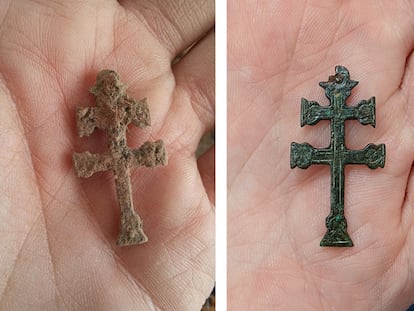Study sheds new light on Tutankhamun’s mysterious dagger ‘born’ from meteorite
Chemical analysis of the artifact has determined that the object was a gift from a king of Anatolia, and was manufactured at a low temperature

In 1922, when the British Egyptologist Howard Carter discovered the relatively intact burial chamber of Tutankhamun’s tomb in the Valley of the Kings in the south of Egypt, he found a mysterious, well-preserved iron dagger among the piled-up objects within. An enigma soon emerged around the dagger’s origin and manufacture, with a roughly polished double-edged blade, a hilt made primarily of gold and a prominent sinuous crack in the center.
Tutankhamun reigned during the 18th Dynasty of Ancient Egypt, between 1361 and 1352 BCE. That period corresponds to the Late Bronze Age and, therefore, about a century and a half before iron-processing technology was acquired and its use became widespread during the Iron Age. Some previous artifacts, such as the aforementioned pharaoh’s dagger, were manufactured with the iron of metallic meteorites that reached the Earth’s surface at some point. But this object’s high quality showed that it came from a place where the skill of working meteorite iron was already well established; so its origin and manufacture has remained a puzzle for years.
Today, a new study carried out by a group of Japanese and Egyptian researchers developed in the historic Egyptian Museum in Cairo has shed new light on the dagger. Thanks to non-destructive chemical analysis, the team has been able to determine that the raw meteorite of the dagger blade was most likely octahedrite, the most-common class of iron meteorites. They have also found that the weapon must have been manufactured at low temperature before forging, and that the object was a gift brought from Anatolia.
The origin of Tutankhamen’s iron dagger is crucial as it directly affects the widely accepted history of human civilization from the Bronze Age to the Iron AgeTomoko Arai, a scientist at the Chiba Institute of Technology in Japan
“The origin of Tutankhamen’s iron dagger is crucial as it directly affects the widely accepted history of human civilization from the Bronze Age to the Iron Age,” explains Tomoko Arai, a scientist from the Planetary Exploration Research Center at the Chiba Institute of Technology in Japan, and one of the authors of the study. “The time of King Tut [as he is commonly known in the English-speaking world], around 1,300 BCE, corresponds to the Late Bronze Age, and the Iron Age is believed to have begun around 1,200 BCE,” she adds.
Arai’s team was able to establish that the iron of the dagger came from octahedrite thanks to the analysis of nickel distribution in the blade of the object. In a sense, the nickel map shows the presence of a structure known as the Widmanstätten pattern, a type of lamellar print present in metallic meteorites such as octahedrite. In the case of Tutankhamun’s dagger, these lamellar prints were about one millimeter thick, imperceptible to the naked eye due to the polishing treatment carried out on the object.
As for the weapon’s manufacture, researchers point out that the preservation of the Widmanstätten pattern rules out the high-temperature forging method. On the other side, the extensive loss of sulfur, manifesting in the form of dark spots on the blade of the dagger, suggests that it was heated up to a temperature between 700 and 950ºC; a range corresponding to low to moderate temperature heating.
“The dagger must have been manufactured with low to moderate temperature forging, allowing the survival of the Widmanstätten pattern during manufacture,” Arai explains. “Previous studies didn’t find the Widmanstätten pattern because it can’t be perceived in plain sight. [But] the structure appeared once we carried out the mapping of nickel elements in the entire surface of the dagger,” she adds. “That was our ‘wow’ moment”.
The origin is another mystery around Tutankhamen’s blade. In the Amarna Letters, a diplomatic correspondence written on clay tablets and discovered in a royal archive in the south of Egypt, there is a list of gifts sent by King Tushratta of Mitanni in Anatolia, to Pharaoh Amenhotep III, Tutankhamun’s grandfather of Ancient Egypt when he married Princess Tadukhipa, the daughter of Tushratta. Among the gifts mentioned in the list is a dagger with an iron-made blade.
Ptolemaic period
The research of Arai’s team states that this is very likely to be the same dagger for two main reasons. The first being that iron-processing technology was already common practice at the time in the Mitanni regions. And second, because the dagger’s gold hilt shows a low percentage of calcium with no sulfur. This feature indicates the use of lime plaster as an adhesive material for the decoration of this part of the object, a frequently used material in Mitanni, which was used in Egypt until several centuries later, during the Ptolemaic period.
“Based on the currently available evidence we obtained through the non-destructive and contactless chemical analysis, our suggestion is the kingdom of Mitani in Mesopotamia as the object’s origin,” explains Arai. She won’t, however, consider the mystery solved: “This is not yet a definitive conclusion.”
Tu suscripción se está usando en otro dispositivo
¿Quieres añadir otro usuario a tu suscripción?
Si continúas leyendo en este dispositivo, no se podrá leer en el otro.
FlechaTu suscripción se está usando en otro dispositivo y solo puedes acceder a EL PAÍS desde un dispositivo a la vez.
Si quieres compartir tu cuenta, cambia tu suscripción a la modalidad Premium, así podrás añadir otro usuario. Cada uno accederá con su propia cuenta de email, lo que os permitirá personalizar vuestra experiencia en EL PAÍS.
¿Tienes una suscripción de empresa? Accede aquí para contratar más cuentas.
En el caso de no saber quién está usando tu cuenta, te recomendamos cambiar tu contraseña aquí.
Si decides continuar compartiendo tu cuenta, este mensaje se mostrará en tu dispositivo y en el de la otra persona que está usando tu cuenta de forma indefinida, afectando a tu experiencia de lectura. Puedes consultar aquí los términos y condiciones de la suscripción digital.











































